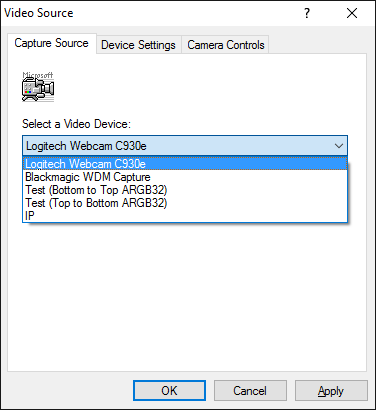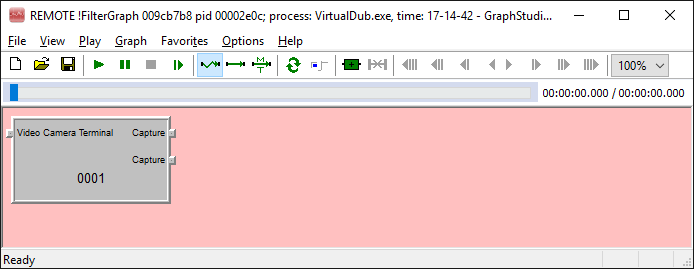A StackOverflow question (already deleted) asked about use of indices when referencing Video for Windows (VFW) capture devices such as in capGetDriverDescription API and other. Video capture with Video for Windows allowed use of up to 10 devices (did anyone have that many at that time?). The numbering was API specific and at the latest stage the documentation described it as:
Plug-and-Play capture drivers are enumerated first, followed by capture drivers listed in the registry, which are then followed by capture drivers listed in SYSTEM.INI.
Even though it is a legacy API, and the API was really really simple and limited in capabilities, it still exists in all Windows versions, there is still some code running, and due to complexity of modern APIs some people still use it in VB.NET and C# projects.
There is, however, a trap involved if someone attempts to use multiple cameras using VFW. VFW drivers are no longer developed since… Let us see what VirtualDub says about dates and how ancient they are:
The newer type of video capture driver in Windows uses the Windows Driver Model (WDM), which was introduced in Windows 98 and 2000. The Microsoft DirectShow API is the primary API to use these drivers. Because the DirectShow API supports a larger variety of commands and settings than VFW, the functionality set of a WDM driver is significantly improved.
DirectShow is a much more complex API than VFW, however, and WDM-model drivers historically have been a lot less stable than their VFW counterparts. It is not unusual to see problems such as capture applications that cannot be closed, because their program execution is stuck in the capture driver. WDM is the proscribed driver model going forward, however, so the situation should improve over time.
All new drivers were WDM drivers for 15+ years. In order to provide backward compatibility later between VFW and WDM, Microsoft came out with Microsoft WDM Image Capture (Win32) driver. Windows versions up to Windows 10 include it, and it is the only VFW driver in the system. In turn, it manages one of existing WDM-driver devices of choice and exposes video capture functionality to VFW applications. If there are two or more WDM drivers, the VFW driver offers to choose between the devices.
The screenshot displays a long standing bug with this driver: it offers choices of all registered DirectShow video capture devices (it enumerates CLSID_VideoInputDeviceCategory category) and reality is that it can only work with WDM devices and not other (more on this below).
VirtualDub has a mention of this driver as well:
If you have a Windows Driver Model (WDM) driver installed, you may also have an entry in the device list called Microsoft WDM Image Capture (Win32) (VFW). This entry comes from a Microsoft driver called VFWWDM32 and is a wrapper that allows WDM-model drivers to be used through the older Video for Windows (VFW) API. The WDM driver that is adapted can be selected through the Video Source driver dialog.
There are unfortunately some quirks in the way this adapter works, and some video capture devices will work erratically or not at all through this wrapper. Device settings not accessible through VFW will also still not be available when using it. If possible, use the capture device directly in DirectShow mode rather than using the VFWWDM32 driver.
This is works pretty nice with VFW API and applications. Even though the are all ancient and deprecated years ago, the system still has bridge to newer devices and applications can leverage their functionality. The problem is that there is only one VFW driver, and its index is zero. If you need two cameras you’re busted.
VFWWDM32 itself does not use any system exclusive resources and there is no reason why its different instances could not be configured with different WDM devices. However, VFWWDM32 is a simple old wrapper, either thread unsafe or such as implemented as singleton. People complain the operation with two cameras is impossible or unstable. It is still possible to run two different processes (such as, for example, VirtualDub) with two completely different VFWWDM32’s which do not interfere because of process boundary and run fine. WDM device is selected using capDlgVideoSource interactively, developers had hard time to do selection programmatically.
The interesting part is how VFWWDM32 does video capture using WDM. It is a cut corner in development: instead of doing simple DriectShow graph with Source –> Renderer, or Source –> Sample Grabber -> Renderer topology, where the wrapper would easily support all DriectShow video devices, including virtual, they decided to implement it this way:
One-filter graph, where the filter is the WDM Video Capture Filter for the device in question.
- the graph is
CLSID_FilterGraphPrivateThreadtype, *FINALLY* it is found what this undocumented flavor of DirectShow filter graph is used for - source filter output pins are not terminated, not connected to anything else
- the graph is never run, produces VFW output in stopped state
Instead, VFWWDM32 uses some private undocumented communication to the WDM filter internals to run the device and receive frames.
Bottom line: VFW is a backward compatibility layer now on top DirectShow. DirectShow and Media Foundation both use WDM drivers to access video capture devices. Artificial constrain caused by simplistic implementation of VFWWDM driver is a limit of one video camera per process at a time.

